What's Happening
Making a Difference—The Let’s Move! Program
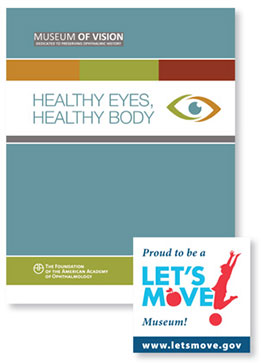 |
| HEALTHY VISION WITH LET’S MOVE! The Academy’s Museum of Vision is participating in Mrs. Obama’s Let’s Move! Museums and Gardens campaign. |
In May 2011, First Lady Michelle Obama started Let’s Move! Museums and Gardens, a subdivision of the national Let’s Move! program for eliminating childhood obesity within a single generation. One goal of the initiative is to provide widespread access to affordable health education. In August 2011, the Academy’s Museum of Vision teamed up with the Let’s Move! campaign to create a free guide, Healthy Eyes, Healthy Body, for parents and teachers to use when discussing the importance of health with their children. In the last year, Healthy Eyes, Healthy Body was used to educate an estimated 12,000 students.
The National Eye Institute notes that 40 to 45 percent of Americans diagnosed with diabetes develop diabetic retinopathy, one of the leading causes of blindness in the United States. The Museum hopes that Healthy Eyes, Healthy Body will aid in reducing these numbers. The curriculum covers eye anatomy and function as well as the relationship between diet, exercise, and eye health. It also briefly discusses eye protection and diabetic eye disease.
The Museum offers three more guides: Eye Openers uses optical illusions to explore rudimentary concepts of vision; Animal Eyes looks at vision in animals; and Art and Vision teaches techniques to create the illusion of depth. The guides are written for children ages 11 and up. The writers kept in mind federal science curriculum guidelines as well as curriculum standards from larger states such as California, Texas, and New York.
Lucia Dantzler, a science teacher in Ridgeville, S.C., found the guides to be very useful tools in the classroom. She said, “Thank you for your efforts in educating all of us in an interesting way! My students really enjoyed the activities.” The guides are also handy for physicians who volunteer to teach students about ophthalmology, vision, and eye health. Together, the four guides likely reached 45,250 kids in the last fiscal year—a significant impact, which the Museum hopes to expand upon in the upcoming months.
Download these guides at www.museumofvision.org/education.
Take Notice
Ask the Ethicist: “Premium” IOL Advertising
Q: I was approached by sales representatives for several presbyopia-correcting intraocular lenses, and I was encouraged to use “premium” lenses to avoid “falling behind competitors” in my area who were already using the “more-advanced” technology. I wanted to offer the best for my patients but was not sure how to begin marketing the new lenses in my practice. The sales representatives encouraged me to do three things: 1) tell patients that I offer “premium” lens technology that will allow them to see everything from near to far, 2) tell patients that they have the option of using the “government issue” lens that requires glasses after surgery if they can’t afford the “premium” lens, and 3) tell patients that I would personally use the presbyopia-correcting lens because I would allow only the “best” if I had surgery on my eye. After all, the additional cost is less than many TV sets, and “what is more important than vision?”
Convinced by the sales representatives that the new technology was better, I began following their advice. In the end, I found the presbyopia-correcting lenses had higher rates of visual consequences than monofocal lenses, and I had to remove some of them in frustrated patients. I also had a significant number of patients who needed glasses despite uncomplicated surgery and who complained of visual symptoms that the glasses couldn’t correct. I have not totally abandoned presbyopia-correcting lenses but now use different words when educating these patients. I tell them that we now have lenses that reduce the need for reading glasses but that they do not always accomplish that goal. I also mention that some visual side effects are more likely with these lenses than with a monofocal, resulting in higher explantation rates than with monofocal lenses. Additionally, I make sure to let them know that insurance does not cover the whole cost of these lenses. Now that I understand the lenses better and describe them more accurately to my patients, it is rare for a patient to choose one; however, I will implant them for the properly informed patient who wishes to proceed with the presbyopia-correcting lenses. I feel let down by the sales representatives and, to be honest, by the ophthalmic community, which has been “selling” me these ideas at meetings now for years. Can I submit an ethics complaint against the sales representatives who misled me or against the companies who make the lenses?
A: The answer to your question is no, since the Academy’s Ethics Committee has jurisdiction only over Academy fellows and members. However, an ophthalmologist who claims that a lens implant will always eliminate the need for glasses, when evidence clearly disputes this claim, would potentially be in violation of Rules 2 and 13 of the Academy’s Code of Ethics; potentially be at increased risk of medicolegal liability; and may be in violation of Federal Trade Commission (FTC) advertising regulations.
It is the ophthalmologist’s obligation to be the expert, rather than to rely on the advice of a sales representative. Ultimately, the ophthalmologist is responsible for the consequences of any misleading advertising or inadequate informed consent. From a liability perspective, promotional comments must be consistent with information provided in the informed consent discussion. Most states now have consumer protection laws that make it easier for patients to claim false advertising, which is not usually covered by professional liability policies and may allow a plaintiff to ask for punitive damages.
Although the more recent changes that you made in your practice do appear to bring your practice into alignment with requirements of the Code of Ethics, it is important to understand that it was you, not the sales representative, who may have been in violation of the Code when you implemented the three recommendations outlined above in your surgical practice.
For more information about appropriate professional advertising for newer technologies, please see the FTC’s relevant materials at www.ftc.gov/bcp/guides/eyecare2.shtm and the joint Academy-ASCRS-ISRS statement regarding advertising refractive procedures (www.aao.org/about/policies). Although these materials address refractive surgery, the issues are equally applicable to presbyopia-correcting lenses and femtosecond laser cataract surgery.
For more information about the principles, rules, and administrative procedures of the Academy, visit www.aao.org/ethics and select “Code of Ethics.”
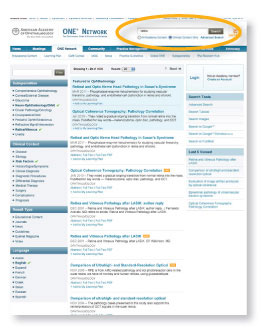 ONE SPOTLIGHT: Improved Search Function. The search function on the ONE Network has been upgraded to make it easier for you to find the information you need. Quickly home in on your content with filters for subspecialty, content type (video, journal article, etc.), clinical context (disease, etiology, diagnosis, complications, etc.), and language. Identify whether the content is a CME credit-bearing activity. Expand your search with links to PubMed and Google Scholar. The improved search box, located in the top right corner of every page on the ONE Network, is a great way to sort through the information on the site. ONE SPOTLIGHT: Improved Search Function. The search function on the ONE Network has been upgraded to make it easier for you to find the information you need. Quickly home in on your content with filters for subspecialty, content type (video, journal article, etc.), clinical context (disease, etiology, diagnosis, complications, etc.), and language. Identify whether the content is a CME credit-bearing activity. Expand your search with links to PubMed and Google Scholar. The improved search box, located in the top right corner of every page on the ONE Network, is a great way to sort through the information on the site.
To start exploring, visit www.aao.org/one. |
Academy Store
Educational Materials for Diabetic Patients
November is Diabetic Eye Disease Awareness Month. Provide your patients with the Academy’s ophthalmologist-reviewed materials about eye diseases that are more common among people with diabetes than nondiabetics. These materials include the following:
- Understanding Diabetic Retinopathy on DVD (#050118) or download (#050126V); Understanding Glaucoma on DVD (#050111) or download (#050128V). Each costs $225 for members and $295 for nonmembers.
- Brochures on diabetic retinopathy (#051088), glaucoma (#051062), and detached and torn retina (#051094). Each package of 100 is $35 for members and $50 for nonmembers.
- Downloadable handouts (PEHANDOUTS) with nearly 100 titles across all subspecialties. A one-year subscription is $275 for members and $370 for nonmembers.
To view video clips, see samples, and order, please visit www.aao.org/store.
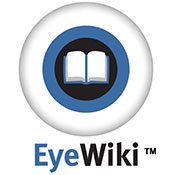 RESIDENTS: Contribute to EyeWiki for a Chance to Win a Trip to the Mid-Year Forum. EyeWiki is a collaborative online encyclopedia where ophthalmologists and residents can read, write, and edit clinical articles. It is also a great resource for nonophthalmic physicians, patients, and the general public. Four residents or fellows can win an all-expenses-paid trip to the Mid-Year Forum in Washington, D.C., in April 2013. For a chance to win, submit your high-quality EyeWiki article by Dec. 1, 2012. Contributing to EyeWiki is not only an opportunity to win a prize but also a way to participate in a site that is read by your colleagues, patients, and the general public. RESIDENTS: Contribute to EyeWiki for a Chance to Win a Trip to the Mid-Year Forum. EyeWiki is a collaborative online encyclopedia where ophthalmologists and residents can read, write, and edit clinical articles. It is also a great resource for nonophthalmic physicians, patients, and the general public. Four residents or fellows can win an all-expenses-paid trip to the Mid-Year Forum in Washington, D.C., in April 2013. For a chance to win, submit your high-quality EyeWiki article by Dec. 1, 2012. Contributing to EyeWiki is not only an opportunity to win a prize but also a way to participate in a site that is read by your colleagues, patients, and the general public.
For complete details and to view past winning articles, visit www.aao.org/eyewiki. |
New Patient Education Brochures
Save time on chairside education and strengthen your informed consent process with these newly developed patient education brochures from the Academy:
- Dilating Eye Drops (#051163)
- Treating Facial Lines and Wrinkles (#051162)
Each package of 100 is $35 for members and $50 for nonmembers.
To see samples and order, go to www.aao.org/store.
Code Accurately and Pass the Ophthalmic Coding Specialist Exam
Revised for 2013, the Ophthalmic Coding Series is available in two parts: The Essential Topics book and the Specialty Topics collection. The series provides a solid coding foundation and serves as the primary study guide for the open-book Ophthalmic Coding Specialist Exam, the only exam that tests coding competency in ophthalmology.
Essential Topics contains information that every ophthalmic practice should have: CPT and ICD-9 coding, major and minor surgical procedures, modifiers, and more. The Specialty Topics collection contains eight modules and one downloadable PDF module, also sold separately, that address subspecialty-specific coding challenges. Essential Topics (#0120321) and Specialty Topics (#0120322) are each $285 for members and $475 for nonmembers. Each module from the Specialty Topics collection is also sold separately and costs $45 for members and $75 for nonmembers.
For details and sample pages, visit www.aao.org/codingproducts. To sign up for the exam, go to www.aao.org/ocs.
Get a Closer Look at Ophthalmic Procedures With Academy DVDs
Watch as the experts discuss and demonstrate a wide variety of ophthalmic procedures and tools. The Academy’s DVDs offer informative, vivid footage and expert commentary and tips. Recently added titles include the following:
- Complications During Cataract Surgery: Anesthesia, Positive Pressure, Zonular Damage, IOL Problems, and More (#0252432). In this DVD, Robert Osher, MD, discusses the problems that can occur suddenly and unexpectedly during cataract surgery. Topics include complications caused by anesthesia and positive pressure, injury to the zonules, anterior chamber hemorrhage, IOL mishaps, and more. Dr. Osher shares management approaches gleaned from more than 30 years of performing and filming surgical techniques.
- Diagnostic Imaging of Retinal Disease (#0252431). Learn how common imaging techniques, such as fundus photography, angiography, autofluorescence, ultrasound, and optical coherence tomography (OCT), are used in the diagnosis of retinal disease. Hear about the basic principles of each technique and how each may be applied in practice. Case presentations review the most important features to recognize for diagnosing disorders including wet and dry age-related macular degeneration, diabetic retinopathy, and retinal vein occlusion.
Each DVD is $140 for members and $190 for nonmembers.
To order, visit www.aao.org/store. You can also preview and purchase all Academy DVDs during the 2012 Joint Meeting at the Resource Center (Booth 508).
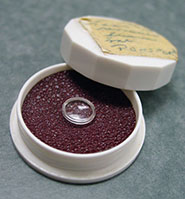 MUSEUM: This Month in Ophthalmology. The history of the intraocular lens (IOL) has its origins in World War II. Sir Harold Ridley, MD, observed that pieces of PMMA cockpit canopies that penetrated the eyes of injured Royal Air Force pilots did not incite inflammatory foreign body reactions. That observation set in motion the research leading to the world’s first IOL implant surgery, performed by Dr. Ridley on Nov. 29, 1949, although widespread adoption of IOLs was slow. Many years later, he said, “Was intraocular surgery started a generation too soon? No, the time was both right and ripe. Immediately after a major war many were accustomed to accepting risk of injury. If implants had not started in 1949, they might have been delayed for yet another 40 years.” MUSEUM: This Month in Ophthalmology. The history of the intraocular lens (IOL) has its origins in World War II. Sir Harold Ridley, MD, observed that pieces of PMMA cockpit canopies that penetrated the eyes of injured Royal Air Force pilots did not incite inflammatory foreign body reactions. That observation set in motion the research leading to the world’s first IOL implant surgery, performed by Dr. Ridley on Nov. 29, 1949, although widespread adoption of IOLs was slow. Many years later, he said, “Was intraocular surgery started a generation too soon? No, the time was both right and ripe. Immediately after a major war many were accustomed to accepting risk of injury. If implants had not started in 1949, they might have been delayed for yet another 40 years.”
This month, in honor of Veterans Day, the Museum of Vision will feature the “Eyes of War” exhibit on www.museumofvision.org. In this exhibit, you will learn more about Ridley’s innovations as well as the stories of ophthalmologist soldiers, freedom fighters, and prisoners whose lives were changed forever by the experience of war.
Learn more about Sir Harold Ridley at www.museumofvision.org/bios. |
D.C. Report
Future Penalties Based on 2013 Participation
In 2015, the Centers for Medicare & Medicaid Services (CMS) will begin penalizing physicians who do not successfully participate in currently voluntary Medicare value-based incentive programs. Despite the protests of the Academy and other medical associations, CMS will base penalties imposed in 2015 on a physician’s lack of 2013 participation in the Medicare Physician Quality Reporting System (PQRS), e-prescribing, and electronic health record (EHR) incentive programs—two years earlier than Congress intended. Congress passed legislation beginning in 2008 to create these programs, which increasingly move Medicare toward value-based purchasing for physician services. To implement the laws, CMS initiated value-based programs that pay incentives to physicians who voluntarily adopt new technologies such as e-prescribing and EHR systems; report on quality measures through PQRS; and pay greater attention to resource use. CMS will begin applying a value-based modifier—a payment adjustment based on a provider’s quality of care and resource use—to physician services in 2015.
Since these programs were first proposed, the Academy has worked to ensure that ophthalmologists are able to succeed and qualify for the Medicare incentive payments. In the past year, ophthalmologists have received more than $100 million in incentive payments for their successful participation in PQRS, EHR, and e-prescribing programs.
The Academy is seeking relief for ophthalmologists from requirements and penalties related to these value-based programs. CMS has proposed that physicians only have to report on one quality measure in the PQRS program in 2013 to avoid being penalized in 2015. However, physicians must successfully report on multiple quality measures in 2013 to qualify for the PQRS incentive payment. CMS has also finalized several exemptions from the EHR program penalty, including newly practicing physicians, those practicing in rural areas, and those practicing in multiple locations who do not have control over the availability of an EHR. The Academy is part of a coalition working with members of Congress to establish similar exemptions for physicians nearing retirement and for members of small physician practices. CMS is also giving physicians who have not previously participated in the EHR program until Oct. 1, 2014, to demonstrate meaningful use of an EHR system.
The Academy website provides educational resources for ophthalmologists to prepare for success in the Medicare value-based programs in 2013 and beyond.
Potential Medicare Penalties in 2015 (based on 2013 participation)
|
| PQRS |
–1.5% |
| EHR Incentive Program |
–1.0% |
| Value-Based Modifier |
–1.0% |
| Total |
–3.5% |
Members at Large
Annual Academy/State Society Collaboration Focuses on Veterans’ Vision
J.R. Martinez, wounded warrior and former U.S. Army soldier who sustained severe burns on more than 40 percent of his body while serving in the war in Iraq in 2003, was master of ceremonies during the 94th Annual American Legion National Convention held Aug. 24-30 at the Indiana Convention Center in Indianapolis. Attending this convention were delegates representing each of the Legion’s 55 departments: the 50 states, the District of Columbia, the Commonwealth of Puerto Rico, France, Mexico, and the Philippines.
Also present at the convention were volunteers from the Indiana Academy of Ophthalmology (IAO), who provided complimentary glaucoma screenings to veterans and their families at the Academy’s booth. “This was a great opportunity for the IAO to provide care and service, as well as to educate our nation’s veterans and their families about eye diseases and conditions. We were very pleased to collaborate with the Academy on this important effort,” noted Andrew W. Tharp, MD, IAO president.
“IAO members screened approximately 200 individuals over the course of the convention and found serious pathologies, including detached retinas and new glaucoma cases,” said Dr. Tharp. The IAO contingent providing the screenings included Melissa Ajunwa, MD, Adam Brazus, MD, Yara Catoira-Boyle, MD, Tina Damarjian, MD, Caroline Denwood, MD, Nisha Kheradiya, MD, Keith Knuth, MD, Elliot McKee, MD, Jason Ou, MD, Ryan Prall, MD, and Derek Sprunger, MD. In addition, medical students aspiring to become ophthalmologists and who are members of the Indiana University School of Medicine’s Sight Savers program volunteered.
“The Academy’s Secretariat for State Affairs commends the IAO and its leadership for its collaboration with the Academy to represent ophthalmology at the American Legion’s convention. The Academy makes it a priority to provide this important service each year to our veterans, and we are already looking forward to our upcoming participation in the 2013 convention in Houston,” said the Academy’s senior secretary for Advocacy, Cynthia A. Bradford, MD.
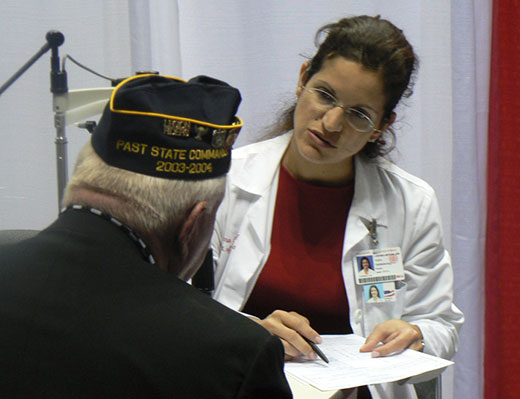 |
Ophthalmologists screened veterans for glaucoma at the 2012 American Legion Convention.
|
Passages
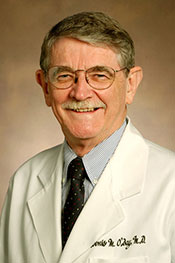 |
| Denis M. O’Day, MBBS (1935-2012). In addition to his roles as leader and educator, Dr. O’Day earned a reputation as a researcher, cornea surgeon, and expert at diagnosing unusual cases of corneal infections and fungal disease. |
Denis M. O’Day, MBBS, a physician from Melbourne, Australia, who had a major impact on the profession of ophthalmology in the United States, died on Sept. 9 after a prolonged illness. He was 76.
As executive director of the American Board of Ophthalmology from 1996 to 2006, Dr. O’Day oversaw the challenging transition to recertification, championing the importance of the new process in upholding the quality of care. He held many other leadership roles, including chairman of ophthalmology and visual sciences at Vanderbilt University, Nashville, from 1992 to 2002.
The American Ophthalmology Society presented Dr. O’Day with its prestigious Howe Medal in 2009. The following year, Vanderbilt University established the Denis M. O’Day, MBBS, Chair in Ophthalmology and Visual Sciences.
“Dr. O’Day was a car-ing and gifted clinician, a marvelous, beloved teacher, a respected leader, and an ardent advocate for our patients and our profession,” said Paul Sternberg Jr., MD, who now chairs the ophthalmology department at Vanderbilt. “He will be deeply missed by colleagues, trainees, patients, and their families.”
People
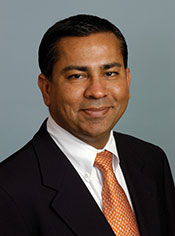 |
| Rohit Varma, MD. |
As of Oct. 8, Rohit Varma, MD, MPH, is the University of Illinois at Chicago’s new professor and chairman of ophthalmology and visual sciences as well as the associate dean for strategic planning at UIC’s College of Medicine. “Dr. Varma is a highly accomplished physician-scientist and translational investigator who has dedicated his career to studying the development of eye diseases in minority populations and to examining novel biological, genetic, and lifestyle factors related to the risk of developing eye diseases,” said Dimitri T. Azar, MD, MBA, dean of the college of medicine. Dr. Varma has extensive achievements, awards, research, and degrees in the field of ophthalmology.
Dr. Azar said, “The members worked tirelessly to conduct this national search … I am confident that Dr. Varma will lead our department of ophthalmology and visual sciences into a new era of clinical and research excellence.”
On Sept. 14, James G. Fujimoto, PhD, David T. Huang, MD, PhD, Carmen A. Puliafito, MD, MBA, Joel S. Schuman, MD, and Eric A. Swanson, MS, received the 2012 António Champalimaud Vision Award from the Champalimaud Foundation for their development of OCT. David R. Williams, MA, PhD, also received the 2012 Vision Award for his contributions to adaptive optics technologies.
According to the Champalimaud Foundation, “These two techniques for visualising the living retina … are dramatically changing ophthalmic practice and our understanding and management of ocular aging and disease.” President Lenor Beleza said “The António Champalimaud Vision Award was designed to support those who are contributing to the alleviation of eye diseases and changing science and technology. This year’s award recognizes pioneering work that represents a historical breakthrough.” The Champalimaud Foundation supports biomedical science researchers in order to fuel innovative methodologies by incorporating both research scientists and medical practitioners.
Who’s in the News
Mark Mifflin, MD, and Zach Joos, MD, were interviewed by Fox News 13 for a Sept. 23 segment on a new technology at the John A. Moran Eye Center at the University of Utah, Salt Lake City, that simulates eye surgeries.
Dr. Mifflin said, “What it does is allow our trainees, our residents who are gaining experience in eye surgery, to go through some of the initial steps of eye surgery before actually working on a patient.”
According to Dr. Joos, “As a beginner, it’s really nice to be able to practice using the microscope, using both feet simultaneously, actually using both hands simultaneously while working in a really tight enclosed space.”